FAQs about WFOs
As we can’t teach at the moment due to Covid 19 lockdown and as many of you are asking questions that you would have asked on our classes, we thought it might be useful to write down the top 10 FAQs we get asked on a regular basis.
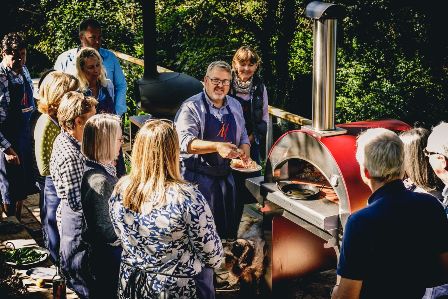
Happy days – teaching a wood fired oven class
So in no particular order –
1. What wood can I use in my wood fired oven?
Any dry, hardwood will be good to burn but moisture content is key. Wet wood produces smoke, steam and much less heat. We recommend a hard wood that you can easily split into kindling and has ideally been kiln dried so its water content is in the mid teens percentage wise. Wood seasoned naturally in the UK will rarely get below 20%. Birch and ash are fast growing so are easy to split. Birch doesn’t leave much in the way of embers so we’ll add something like oak if we want some. Oak and other dense hardwoods are much slower growing so can be knotty and gnarly and much more challenging to split into kindling, even for the most experienced axeman. We get our wood from Logs Direct although there are plenty of suppliers out there. Have a look at more wood stuff here.
2. Why do you split the wood into small pieces?
Smaller pieces of wood are great for starting a fire and then it’s really useful for managing the fire and the temperatures. Say you want to grill something quickly in your oven; if you put a big log on the embers, it will take ages to catch light and burn well and then will burn for a long time. Better to have split that log into 4. If you add a few small pieces they will light up much more quickly, burn brightly, grill your food and then die down again. You’ll need a good axe or log splitter to make the job easier. Try it and see; have a look at how we use kindling to manage the fire and the temperatures here.
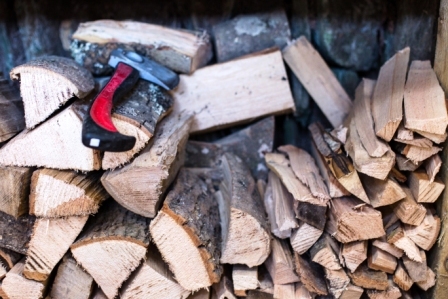
Satisfyingly split wood and kindling
3. I have a lovely spot down the end of the garden where I want to site my oven. Is that a good spot?
If you’re super organised or building a complete outdoor kitchen and dining area then yes, why not?! If the answer to either of those is no then you’ll spend a lot of time walking back and forwards to your kitchen to collect the equipment or the food that you forgot. It’s much easier and consequently you’ll use your oven more often, if it is as close to your regular kitchen as possible. Unless you like walking back and to for a teaspoon, in which case….
4. It’s an outdoor oven; it doesn’t need a cover does it??
Well if you’re living somewhere super dry like the Mediterranean or the Kalahari where the temperatures are high and the weather is dry, then no, not really. If you’re cooking in the UK, say, and you want to cook all year round, some kind of covering structure for your oven will protect it from the worst of the weather (rain, wind and frost) and it means you will use it more often as well as there’s some protection for the cook. The more you use your oven, the more it will be in a state of readiness when you want to cook. If you leave it out in the driving rain, wind, snow and sleet of a British winter (or sometimes Summer) and come back to cook Easter lunch in it, you’ll spend most of the day driving off the moisture the oven has taken up over the winter.
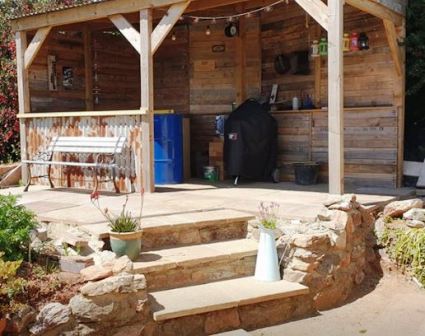
Tim’s Cooking Shack – great job!
5. The oven floor is all dirty and I don’t want to cook on it; what kind of pizza stone should I get?
Well the floor will be dirty if you have been burning a fire but it’s simple to clean with a blowpipe made of a long piece of metal tubing bashed almost closed at one end and with a mouthpiece at the other end to blow through. This is also good for blowing air into your fire if your wood is slow to burn. We also use a hard bristle brush we picked up at the local hardware store for £5. David turned the head of the brush 90 degrees so it brushes side to side rather than front to back. If you want something a little less Heath Robinson, you can buy a lovely brass bristle brush for sweeping your oven and an extendable blow pipe something like this is lovely to work with. Cooking on the floor of the oven is the traditional way of cooking and all ovens we have worked with are designed for you to do this. Only if the oven floor is completely knackered and rough and we couldn’t replace the floor would we think about a pizza stone .
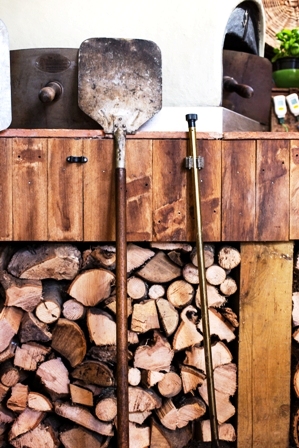
A handy blowpipe
6. It’s all meat and pizzas isn’t it??
There is so much more to wood fired ovens than meat and pizza. If you get in the habit of calling your oven a wood fired oven rather than a pizza oven, then it opens up a whole world of possibilities from fish and seafood like you’ve never tasted before cooked at super high temperatures to meltingly tender overnight stews to cakes, biscuits and pastries. Basically anything you can cook in your regular kitchen, you can cook in your wood fired oven. You can use it as an oven (err, obvs!) but also as a hob, as a grill, as a slow cooker, as a smoker…..you get the idea. Lots of ideas in our youtube playlists here.
7. How hot does the oven get and how do I tell the temperature?
Well we have had one of our ovens up to close to 1000 degrees Celsius so pretty hot…. You wouldn’t want to cook at that temperature obviously; the hottest you want your floor is around 375C for pizzas and other flatbreads you want to cook really quickly. Until you get used to the temperatures and how your oven works, it’s very handy to have an infrared thermometer which will tell you the temperature of where the red dot lands. This will not be the temperature for the whole of the oven though – it’s not like your fan oven in the kitchen. When you’re cooking with fire there will be several different temperatures in the oven at the same time; it’s pretty unstable. So try something like our Mississippi method where we put our hands in the oven, where we are going to cook the food not up in the roof, and see how long we can keep it there. This is not some test of manly fortitude just a guide to see how quickly you can feel the temperature heating up your arm. So that will be how quickly it starts cooking your fish or your chicken or your steak. If that’s the kind of temperature you want, all good; if it’s too hot, wait a while or wonder why your food is always slightly, err, black. 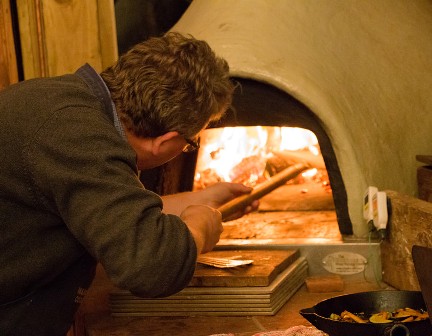
8. I shut the door on my oven and the food looked fantastic but tasted awful…. what did I do??
If you’re cooking with a fire or active embers in the oven, you need to let the smoke escape otherwise the acrid flavours have nowhere to go but into your food. We like an oven with a door that comes off completely that way you can do lots of things with it – take it off when you are cooking with fire, put it on when you are cooking with retained heat in a refractory oven, keep it ajar if there are embers, use it an angle to whoosh air into the oven and into the fire. Who knew you could do so much with a door?!
9. I can’t keep heat in my refractory oven for very long and certainly not overnight.
Remember for the oven to work at its best, you should insulate your refractory oven if it hasn’t come with any inbuilt insulation. Also remember that heat will escape in every direction – down as well as up and to the sides so make sure you insulate underneath your oven before you place it in situ. Also look at point 4 – even if it is insulated in every direction, the better your oven is protected and the more you use it, the better a state it will be in for cooking. Also think of your oven as battery for storing energy. Only if you charge it fully will it stay hot for as long as it can. The larger of our ovens takes a good 90 minutes to 2 hours of heating to get it saturated with heat.
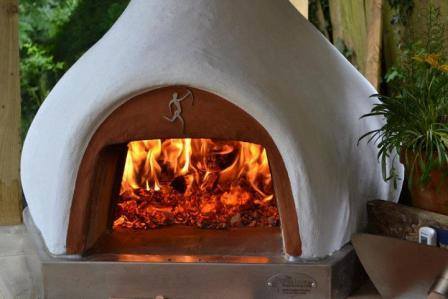
Our well-insulated Bushman
10. My pizzas keep springing back in size when I cook them – what am I doing??
It’s really important that you let your pizza dough relax before shaping it into pizzas. We make our dough the day before we want to use it so it develops well and has a great flavour. We’ll then shape it into dough balls 2-4 hours before using depending on the ambient temperature – if it’s cooler it will take them longer to relax. Basically when you shape the dough balls, you are putting energy into them and you need to relax them otherwise they will spring back as you’ve been experiencing. If they are well relaxed, then the energy has dissipated so they will stretch out well and keep their shape. You won’t have to pretend you wanted to make mini pizzas all along….!Look at how we cook our pizzas .
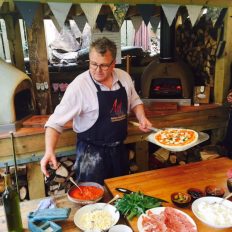
So that’s 10 of our most FAQs – if you have any others, just let us know. You can email us on info@mannafromdevon.com
We hope that run through has been useful. If you like what we’re doing and would like to support our wood fired creativitiy, we’d love it if you could stump up a virtual coffee for us here.
Happy cooking
David and Hollyx


